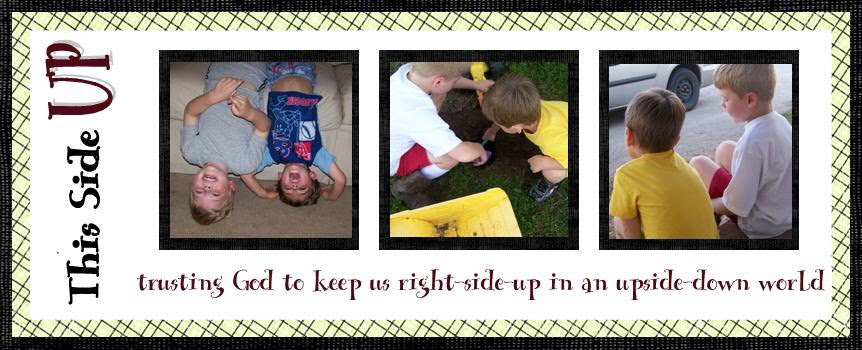We really, really enjoyed the new exhibit. They had a good mix of displays that were detailed and informational enough for adults and hands-on activities for kids. One area had several interactive displays that showed how archaeologists analyze artifacts found in a dig, then had kids look at a sample "dig-in-progress" and determine what had probably happened at the "site" based on the artifacts present. Another area had some pottery pieces that the kids had to assemble to make a jar, showing how hard it can be for archaeologists to sift through and fit together pieces of artifacts. They also got to build a pyramid (with wooden blocks) and experiment with sand in an enclosed wind chamber to see how the sands in Egypt shift to cover/uncover monuments and artifacts.
 |
| The completed pyramid (with our Flat Stanley exchange "visitor") |
They got to experiment with pulling blocks of stone on a flat surface vs. on runners with slats underneath and figure out which was easier and why. And of course--there was a mummy. Not a famous one, but it was still a mummy!
The boys had a good time, but I think it will take another trip or two for them to really catch enough of the history stuff to really make connections with what we've been studying. They did catch some of it (due to my constant, "No--stop and LOOK at this!"), but mostly they were interested in going from one hands-on thing to the next without really stopping to see what they were doing. It was still exciting to begin making those connections, though. We saw jars that were made sometime between 3800 and 3200 BC. I was glad that we'd been working on memorizing history sentences to go along with our studies, because Connor was able to see that those jars had been made before Upper and Lower Egypt had been united into one country, and even before the Sumerians up in Mesopotamia were writing with cuneiform! We were able to look at some photographs from different sites in Egypt and connect them with people we had studied. We checked out scenes from tomb paintings and were able to recognize gods and goddesses we had read about. We saw statues, amulets, and other artifacts from tombs--great concrete examples of things we've read about. And lots and lots of hieroglyphs!
And there were several things that looked interesting to me (like displays explaining how scientists use various kinds of imaging to examine mummies) but that I didn't really get a chance to check out in detail because of the short attention spans of my short companions. I was excited to make another connection of my own, however. I recently read the book The Murder Room: The Heirs of Sherlock Holmes Gather to Solve the World's Most Perplexing Cold Cases by Michael Capuzzo, which features (among other people) the forensic artist Frank Bender, who sculpts faces based on skulls that have been found to help identify crime victims or give faces to the long-dead discovered by archaeologists. Anyway, there were four busts based on mummies (the mummy they had on display as well as 3 others whose images were used in the different displays about how scientists study mummies), and 3 of them--including the one based on the mummy that was there--were done by Frank Bender!
Unfortunately, I didn't get many pictures. I discovered when we got there that I'd left the memory card for the camera at home. Aaron brought it when he met us for lunch, but by then we'd done most of the Egypt stuff (we went back up later for another crack at the pyramid). Also, photography was prohibited in one section of the exhibit. I'll have to make sure we bring it the next time we go and get some pictures of the other hands-on activities. I'm sure we'll be back there in the next couple of weeks!












Wow - this sounds like a GREAT field trip! Ancients is still two years away for us; otherwise, it might be worth it to drive to Ft. Worth to see it! (We live in the Beaumont area.)
ReplyDeleteLast week you left a note on my blog asking about our science. We use My Father's World (Adventures this year), and we just do whatever science is scheduled for the week. So far it has been mostly Usborne books along with whatever library books we find on each week's topic. The experiments are easy, yet they seem to be effective.
I've also heard really good things about the Apologia Young Explorers series by Jeannie Fulbright. The only one I've actually read is Astronomy, and I absolutely loved it! If we weren't doing the MFW science, I'm pretty sure that would be my top pick!